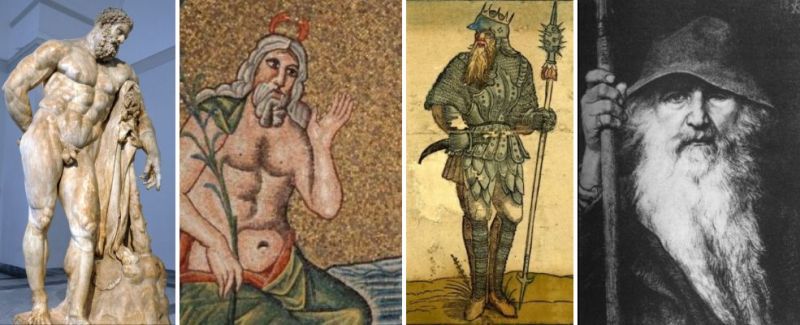
|
Home DH-Debate 1. Society's Values 3. Christian Kingdoms |
| 1. Introduction | 2. Greek City-States |
| 3. Indo-European Peoples | 4. Literature |
Modern Europeans have a self-effacing attitude to the third world's indigenous tribes. They typically believe that the tribes of Africa and South America are authentic, genuine and original, while they have no particular awareness of their own people, except that they may subconsciously perceive themselves and Europeans in general as a kind of artificial ethnographic product.
But the Europeans themselves are descendants of countless small tribes - always ruled by kings - who lived scattered throughout the Eurasian steppe, on the islands in the sea and along the rivers between the mountains of Europe. There are many differences between the African tribes and the indigenous European peoples, but one of the most important is that the European tribes have had greater success throughout history.

|
The ancestors of the European peoples. From left to right:
Many Greek royal houses claimed to be descended from Hercules. Farnese Hercules is an ancient statue of Hercules, probably an enlarged copy made in the early third century AD of Glycon of Athens. He is portrayed as an older muscular man. National Archaeological Museum. Photo Wikimedia Commons Paul Stevenson.
The Goths believed that they descended from Gaut. They became Christians very quickly and probably therefore there is no representation of their mythical ancestor. But in a Loft Mosaic in Arian Baptistery in Ravenna, depicting the Father, the Son and John the Baptist, one can see the Father as an older, muscular and gray-bearded man. One might think that he reflects the Goths' traditional notion of Gaut, as the church was built in the Gothic period. However, he also looks like Hercules.
There is also no original depiction of the Germans' ancestor, Mannus, but he was certainly different from the naked classical Greek style. Photo Folkish Odinism Dorset.
Odin, the All-Father, in his disguise as a wanderer, painted by Georg von Rosen in 1886.
The ancestors of the Europeans were organized in hundreds of small manageable kingdoms spread across Europe and Asia. They were each united by the consciousness of common descent and the holiness of the king. Each people considered themselves the descendants of a distant mythical ancestor, and thus a large family - the Greeks of Heracles, the Germans of Mannus, the Goths descended from Gaut, the Aesirs of Odin and the Romans of Romulus and Remus.
All these peoples have had their songs and tales of the deeds of the past, of their gods, kings and heroes, which have been told by bards and skjalds in long winter evenings. But most legends are gone and forgotten by now. Only some of the names of the peoples are preserved for posterity by Herodotus, Julius Caesar, Tacitus and others.
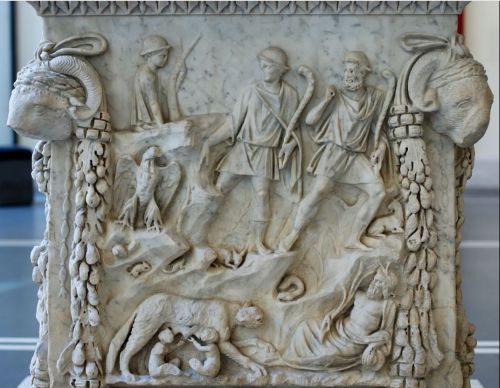
Altar with Romulus and Remus as sucklings from the wolf, Lupa, surrounded by representations of the Tiber and the Palatine. Panel from a marble altar dedicated to the divine pair Venus and Mars, seen at the top. Roman Marble Art from the end of Trajan's reign (98-117 AD), later reused during the Hadrian era (117-132 AD) From the gate of the Piazzale dei Corporazioni in Ostia Antica. Exhibited at the museum in the Palazzo Massimo alle Terme in Rome. Foto Marie-Lan Nguyen Wikipedia.
Jordanes wrote the history of the Goths in Latin. He was himself of Gothic descent. He used the term "gens" about 70 times, and it probably means a group characterized by a genetically determined individuality. It is being translated into English everywhere as "race". For example, he wrote: "For the race whose origin you ask to know burst forth like a swarm of bees from the midst of this island and came into the land of Europe."
Jordanes was not alone in using such terms. Procopius used a similar word in Greek - but not so often - which is also translated into English as "race". He wrote, for example, in connection with the war against Persia: "he would bring great disgrace upon his kingdom and upon the race of the Persians." Priscus wrote that "Prophets had forewarned Attila that his race would fall, but would be restored by this boy."(his son)"
The ancient writers were very interested in how the different peoples looked like. The Angles were tall and blond. The Danes were the tallest in the northern countries. The Cimbri were blonde and strong. The Goths had a completely white skin and their heads were completely round. Macrophages were long-skulled and so on.
It is obvious that in ancient times it was widely recognized that a certain people had a characteristic appearance because they had common ancestry. One could say that one believed that each people belonged to their own very special race.
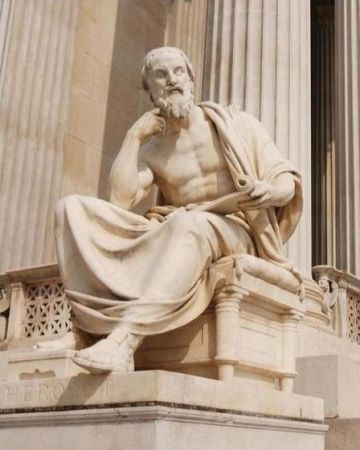
Statue of Herodotus in Athens. Photo Destination Athens.
Herodotus introduced the concept of history - a word that originally meant report or investigation. His "History" is an amazing document. Imagine that he personally traveled around the known world of that time 2,400 years ago, while the Bronze Age was coming to an end in Scandinavia and pyramids were still being built in Egypt. He was in southern Italy, Sicily and Tyre in Phonicia (Lebanon) and he visited the Greek colonies on the Black Sea coast. He traveled in Babylon and not least Egypt and everywhere he inquired about the geographical conditions, religion, customs and history of the places. He wrote it all down in a huge work, which is preserved to our time thanks to diligent monks who have carefully copied the old documents one time after another.
He knew nothing of northern Europe. He wrote: "though I have taken vast pains, I have never been able to get an assurance from an eye-witness that there is any sea on the further side of Europe. Nevertheless, tin and amber do certainly come to us from the ends of the Earth."
Herodotus' work makes it probable that all the small European peoples, without exception, were originally ruled by kings. In his account he mentions about fifty different nations in the known Greek world as kingdoms or he mentions named kings in connection with places and events.
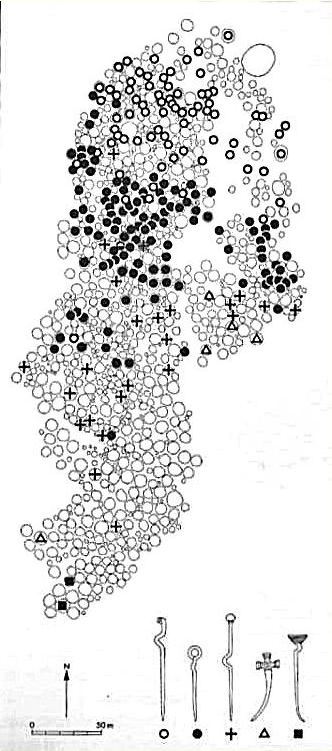
Plan of burial place from Celtic Iron Age - almost simultaneously with Herodotus - at �rupg�rd between Ribe and Gram in Jutland. The large circle at the top right represents a Bronze Age burial mound. The signatures small circle, cross and square and more below represent finds of fibulaes of different types, which are shown above each signature. It is known from other finds that different fibulae-types belong to different periods - fashion also changed in the Celtic Iron Age. It can be demonstrated that the oldest fibulae-types are found most close to the Bronze Age burial mound. Therefore, one can conclude that the village's first burials took place in the side of the old mound or in its immediate vicinity, the following funerals took place near them but a little farther away, and thus the burial ground had slowly spread over the field with the original Bronze Age mound as a starting point.
This makes the entire burial ground's layout similar to a family tree with the original ancestor in the top represented by the mythical king from the Bronze Age, who was lying in the mound. Gyldendal og Politikkens Danmarks Historie 1.
Likewise, in his accounts of the other Indo-European peoples - in the Balkans, the Eurasian steppe, Asia Minor and the rest of Asia - it is a matter of course that they are - or were originally - led by kings. Also Ethiopians, Egyptians, Phoenicians, Libyans, Arabs and Babylonians were all - without exception - led by kings.
Herodotus himself, however, seems to have been strongly fascinated by the idea that a people should be "free" in the sense that it should govern itself by means of a democracy. It shines through that it was a topic that was much discussed in the Greek world in his time.
But democracy remained largely an intellectual idea; only Athens had this form of government for 172 years from the fall of the tyrant Hippia in 510 BC to the defeat to Philip of Macedonia in 338 BC. The democratic periods in a few of the other Greek city-states were quite temporary.
Herodotus writes about the city-state of Corinth: " The government at Corinth was once an oligarchy - a single race, called Bacchiadae, who intermarried only among themselves, held the management of affairs." About Thebes it is known that the city-state in Herodotus' time was led by various tyrants and oligarchies.
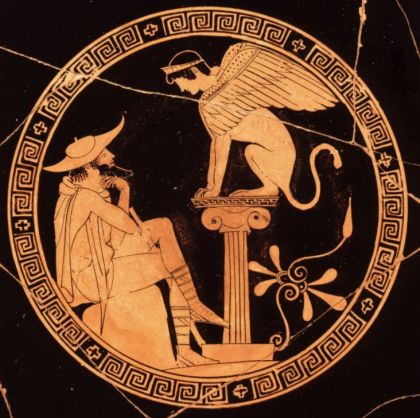
Oedipus meets the Sphinx on the road to Delphi. Photo Vatican Museum.
But Sophocles tells in one of his tragedies that Oedipus' father, Laios, was king of Thebes. It was foretold to him that he would be killed by his own son. Therefore, King Laios leaves his newborn son on a mountainside where he most likely would be killed by wild animals. But, however, he is found by a shepherd, who brought him to the king and queen of Corinth, who were childless. They adopted him and gave him the name Oedipus and here he grew up.
Sophocles' tragedy is fiction, but all fiction is based on the use of familiar probable elements, which are aimed to seduce the reader or spectator into believing that the actions of the narrative are also true. Therefore, it is likely that the tragedy is based on common knowledge in the time of Sophocles and Herodotus that all nations in the past were ruled by kings.
It is well known that the ancient Greeks were organized into city-states, which often hated each other fiercely and waged wars with each other, forming shifting coalitions. For example, when Xerses attacked in 480, many of the northern states entered the war on the side of the Persians, including Thessaly. But the state of Phocis joined the Greek coalition led by Athens and Sparta. Herodotus tells: "The Phocians were the only people in these parts who had not espoused the cause of the Medes; and it is my deliberate opinion that the motive which swayed them was none other - neither more nor less - than their hatred of the Thessalians: for had the Thessalians declared in favour of the Greeks, I believe that the men of Phocis would have joined the Median side."
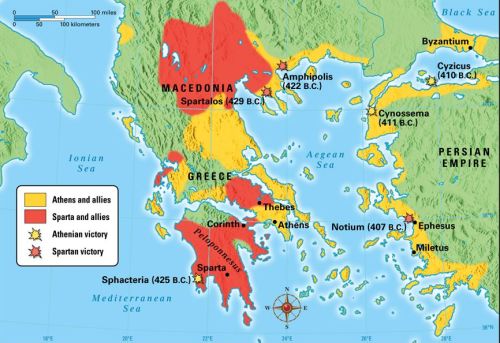
|
Overview of the Ancient Greek States. Most of the smaller states are not shown for the sake of overview. The names of many of the islands are also omitted. Photo Geography Pages.
There were about 150 - 200 Greek city-states, no one knows the exact number. Their names were Athens, Miletus, Sparta, Corinth, Thebes, Argos, Thessaly, Megara, Acadia, Messenia, Samos, Rhodes just to name the most famous. From the dawn of time, they were all kingdoms, but a small proportion of them switched to various forms of tyranny, oligarchy, or even democracy. Herodotus mentions about fifty city-states, which - in his time or in the time immediately before - were ruled by kings.
The difference between kings and tyrants was that kings inherited their office or they were elected kings. They ruled in accordance with ancient laws and closely monitored the worship of the gods supported by a traditional body of advicers consisting of the leading men of the kingdom. Tyrants, on the other hand, seized power with arms and violence and ruled as they saw fit. However, there are several examples of good tyrants who created prosperity and good times in their states. Herodotus mentions Polycrates of Samos and Peisistratus of Athens.
One did not mix genes with anybody. On behalf of the Athenians, Plato (around 300 BC) put it this way: "- - because we are genuine Hellenians and not mixed up with barbarians. Because together with us live no Pelops or Kadmos or Aygyptos or Danaos or any other, which by nature are barbarians, and only according to the law are Hellenians. We are true Hellenians and not bastards." (Menex 245 d)".
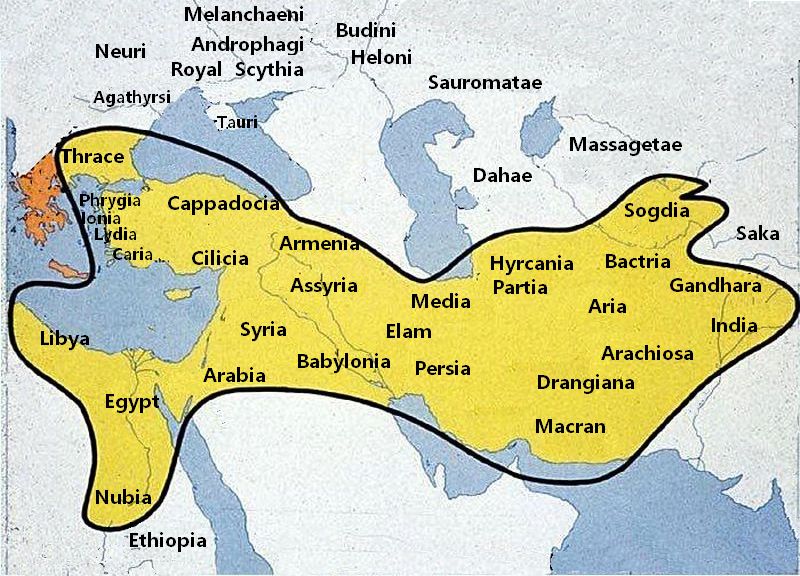
Ancient peoples of Herodotus' time - inside and outside the Persian Empire.
Around the year 100 BC the famous Chinese historian Sima Qian wrote about a - presumably Indo-European - people at the northern border of the empire, whom the Chinese called Yuezhi. They were led by kings. Sima Qian wrote: "They cut their hair at the shoulders, except the king, who wore long hair, tied up with a ribbon."
A few years later - around 55 BC - Caesar told in his "Gallic War" about how in only 10 years he conquered the area we know today as Switzerland, France and Belgium. These countries were inhabited by many warring peoples, Helvetii, Belgae, Boii, Parisii, Nervii, Arvenians and Allobroges just to name a few. Caesar was also something of an ethnographer and wrote extensively about the tribes his army encountered. The Gallic (Celtic) tribes were ruled by kings, for example Vercingetorix of Arvernia son of Celtillus, Teutomarus of the Nitiobriges son of Ollovicon, Orgetorix of Helvetii and Casticus of Sequani.
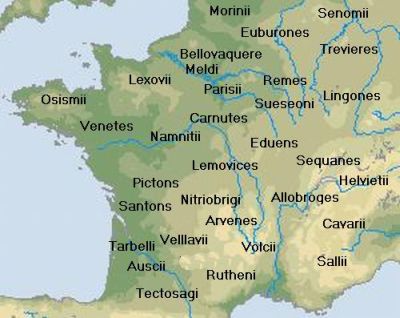
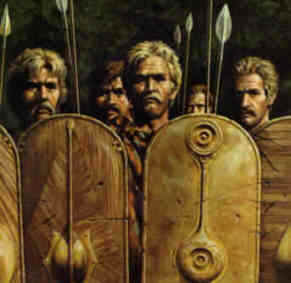
|
Left: The Gallic tribes of Caesar's time.
Right: Celts or Gauls in Caesar's time - possibly a picture from a movie.
Around 100 AD Tacitus told of the area that the Romans called Germania, that it was inhabited by Suevi, Batavians, Frisians, Lombards, Anglers, Semnoes, and many others. Far to the north lived the Cimbri and Gotons "ruled by almighty kings" , he said.
"In the election of kings", Tacitus explains, "they have regard to birth, in that of generals, to valor. Their kings have not an absolute or unlimited power."
He describes a Germanic thing assembly: "When they all think fit, they sit down armed. Silence is proclaimed by the priests, who have on this occasion a coercive power. Then the king, or chief, and such others as are conspicuous for age, birth, military renown, or eloquence, are heard; and gain attention rather from their ability to persuade, than their authority to command. If a proposal displease, the assembly reject it by an inarticulate murmur; if it prove agreeable, they clash their javelins; for the most honorable expression of assent among them is the sound of arms."
Throughout Pliny the Elder's "Natural Historiæ" (around 50 AD) he mentions kings almost a hundred times, whereas democracy is not mentioned at all. Which suggests that it was an extremely rare phenomenon in his time.
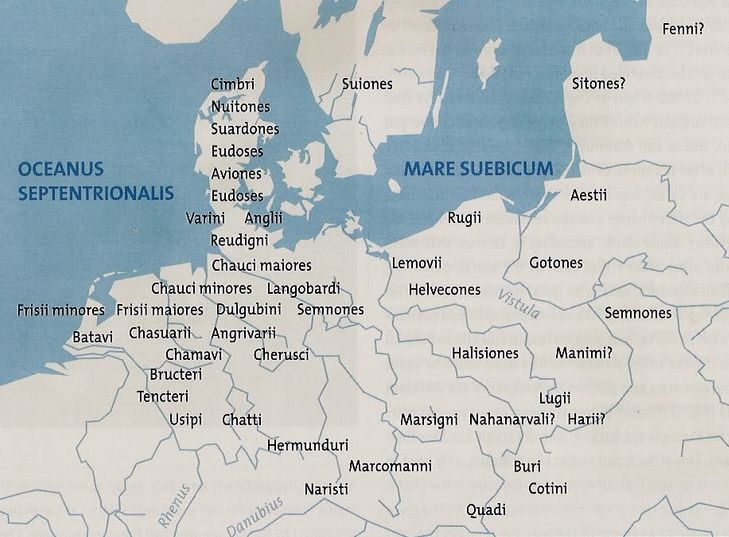
|
Reconstruction of the Germanic tribes after Tacitus. He did not draw a map himself, but many writers have sought to place the tribes on a map after his description. As can be seen, Jutland and North West Germany are becoming somewhat overpopulated at the expense of other regions. Tacitus mentions Varini after Anglii, and this is probably a mistake. We must believe that Varini was the Saxons. From "The Spoils of Victory. The North in the Shadow of the Roman Empire". Edited by L. Jørgensen, B. Storgaard and L.G. Thomsen. Nationalmuseet, Copenhagen.
Faxian (c. 400 AD) was a Chinese Buddhist monk who - at the age of 62 - traveled from China to India on foot and visited sacred Buddhist sites in Central, South and Southeast Asia between 399-412 to acquire Buddhist texts that he wanted to bring back to China. He wrote a travelogue, "A Record of Buddihstic Kingdoms", which obviously tells of the kingdoms he came through on his way through the Tarim Basin, present-day Afghanistan and Pakistan. He traveled through the oasis cities and wrote: "All the kingdoms had thousands of monks, and each kingdom spoke its own barbaric language."
The kingdom of Loulan lay by the now-disappeared salt lake Lop Nor, it was a poor country that still fed thousands of monks, but the king was very hospitable. Faxian also visited Khotan, which was a flourishing kingdom with many monks, with the king leading the Buddhist processions. He told that the inhabitants gathered to cultivate music. They dressed in embroidered robes. Some, however, still wore furs. He remarked that the king was a westerner.
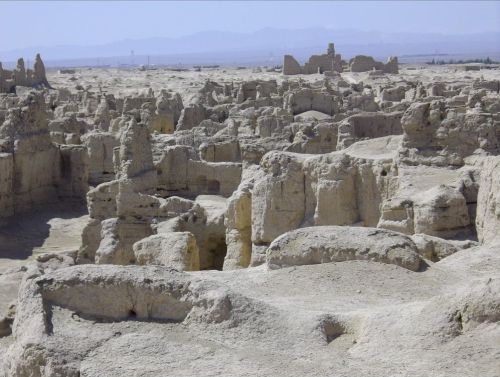
The ruins of Loulan are today far out in the desert, there is not a blade of grass many kilometers around.
In general, it was not allowed to marry outside of ones people. The King of the Eastern Goths in Italy, Theoderic the Great, supported the hard pressed Western Goths in France by sending an army led by a general named Theudis (c. 540 AD), who, however, broke the tradition and married a woman, who was not Gothic. Procopius writes: "But afterwards, Theudis, a Goth, whom Theoderic had sent as commander of the army, took to wife a woman from Spain; she was not, however, of the race of the Visigoths, but belonged to the house of one of the wealthy inhabitants of that land, and not only possessed great wealth but also owned a large estate in Spain." Theudis never appeared later by Theodoric the Great's court in Ravenna.
In Constantinople, Jordanes (around 550 AD) wrote "De Origine Actibusque Getarum", The History of the Goths - also called Getica - about the conditions in Scandinavia. Suehans, Graniers, Auganzes, Ostrogoths, Raumarikes and many more lived in the northern part of the World.
He wrote in Latin. His most important source was a much larger work on the History of the Goths, written by Theoderic the Great's Chancellor, Cassiodorus, a work which, however, has been lost. Jordanes was himself of Gothic descent. He writes: "Now from this island of Scandia, as from a factory of races or a vagina of nations, the Goths are said to have come forth long ago under their king, Berig."
Jordanes lived around 550 AD. in Constantinople. It is believed that the Ostrogoths left Scandza around 150 AD. If a generation is counted as 25 years, it will then be 16 generations since they left the Scandinavian peninsula. In all that time, they had preserved the memory of the land they left long ago, orally from generation to generation. It testifies to a strong sense of national identity. Another possibility is that they had sporadic connections with their original homeland all the time.
When the Eastern Goths suffered a defeat against the Byzantine army at the Battle of Busta Gallorum in Italy 552 AD, the survivors migrated north, up through Italy. They sought refuge with their relatives, the Western Goths, in the south of France. The king of the Western Goths allowed the two peoples to marry each other. It was an exception to the rule that found its way into the history books..
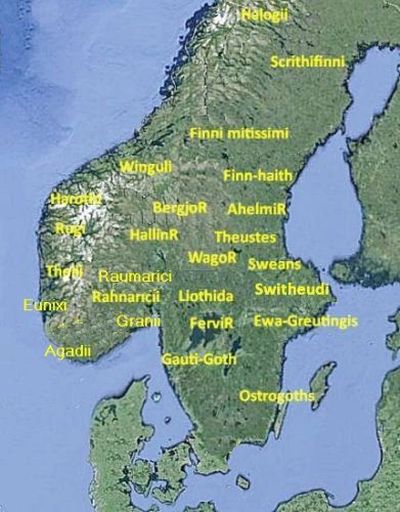
The tribes on the island of Scandia after Jordanes, who himself was an Ostrogoth - quite randomly placed by the author. We can place Halogi, Scrithfinni, Finn Haith and Finni Mitissimi to the north after their names. Sweans and Switheudi around Malern - as we can believe that they are the Swedes. Gautigoths and Ostrogoths in the Gotalands, Dani in Scania and some peoples with names reminiscent of modern Norwegian place names, Raumarici and Agadii, as well as possible in Norway and Ewa-Greutingis near the Goths, as some of these are later called Greuthungi. The rest I have placed pretty randomly.
Another Buddhist monk, Xuan-zang, (c. 650 AD) wrote an account of his journey from China to India and back, where he came across numerous small kingdoms on his way. He visited Khotan returning home from India. He told that the inhabitants were very friendly people. They lived on agriculture and cattle breeding. The Khotans valued music and dance highly.
He also visited the Sogdians in Samarkand:: "The people are brave and energetic. This country is in the middle of the Hu people (or this is the middle of the Hu). They are copied by all surrounding people in point of politeness and propriety. The king is full of courage, and the neighbouring countries obey his commands. The soldiers and the horses (cavalry) are strong and numerous, and principally men of Chih-kia. These men of Chih-kia are naturally brave and fierce, and meet death as a refuge (escape or salvation). When they attack, no enemy can stand before them."
Denmark has always been ruled by kings. Around 1200 AD. Saxo Grammaticus wrote down his huge work Gesta Danorum - The Danes' Achievements - which tells about Denmark's history from a distant past to around 1185. He lists between 100 and 200 Danish mythological kings from before Gorm the Old. Some probably are mentioned in several legends and there have probably been several kings of the same name, among others a king Frode is mentioned 18 times, king Dan 3 times, king Erik 5 times and so on. Even more have certainly been forgotten and not mentioned at all.
Snorre Sturlason - who lived almost at the same time as Saxo Grammaticus - left no doubt that Norway has also always been ruled by kings. He wrote Heimskringla, which is a history book about all Norway's kings from Halvdan Svarte in 850 e.Kr. to King Sverre Sigurdsson around the year 1200 AD.
|
The Histories - Herodotus Roman Road Static The Geography of Strabo Vol 1 Gutenberg The Geography of Strabo Vol 2 Gutenberg The Geography of Strabo Vol 3 Gutenberg Gallic Wars -Julius Caesar Cliffs Notes The Gallic Wars - Julius Caesar Classics Archive Pliny's Natural History. Internet Archieve Tacitus: Germania - H.H. Lefolii Ribe Katedralskole The Journey of Faxian to India Washington.edu A Record of Buddhistic Kingdoms - Fa-Hsien Gutenberg Xuanzang's Record of the Western Regions Washington.edu Jordanes Getica Harbornet Procopius - The Gothic War Gutenberg Priscus at the court of Attila the Hun Macedonian Truth Forum Snorre Sturlasson Kongesagaer Heimskringla Danmarks Krønike -Saxo Grammaticus Heimskringla The Germanic Peoples. Odins Volk |
| Til start |